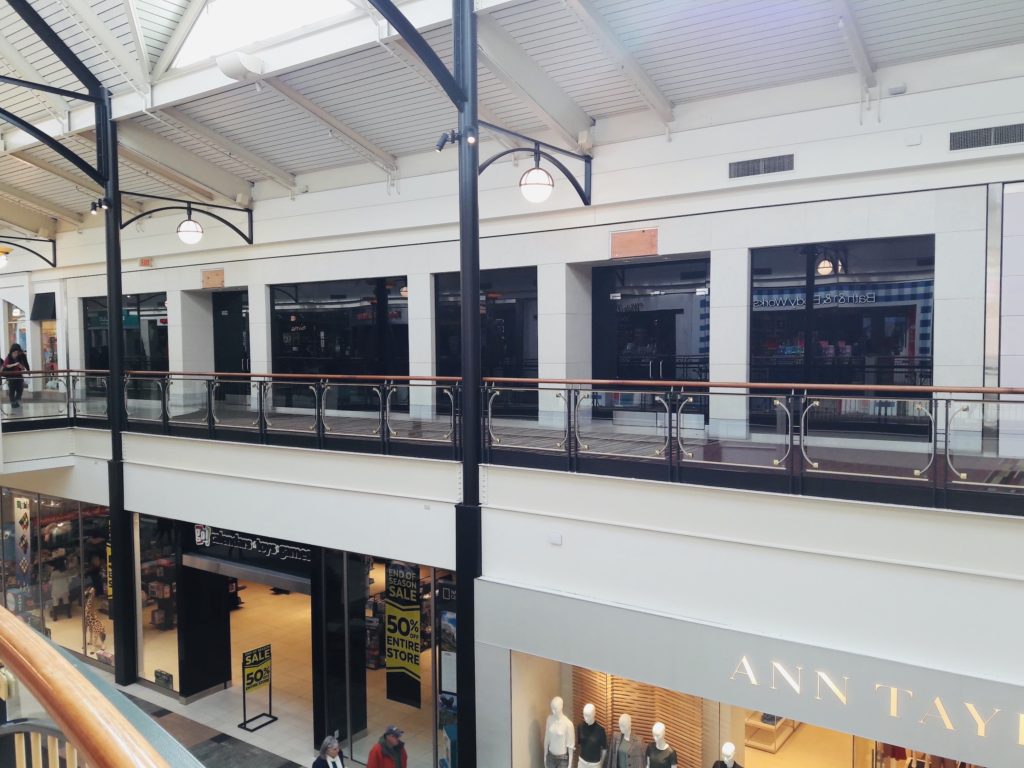It’s a tough time for shopping malls in America. The once mighty bastions of indoor retail have fallen on hard times as more and more people shop online. Just this week, Macy’s announced it will close 125 mall locations around the country. (No word yet on which stores will close or whether it will affect the Macy’s in Sterling.)
Loudoun’s main mall — the Dulles Town Center — is no exception to the tough times. In recent months, a good number of stores have closed their doors at the mall, leading many in the community to speculate about what the future holds.

The Burn has gathered information from commercial real estate professionals that might help shed light on what is happening at the Dulles Town Center and elsewhere.
- There’s no doubt that there are empty stores at the Dulles Town Center. Two of the five main department store anchor spaces are empty — the former Nordstrom’s, which closed in 2017 and the former Lord & Taylor, which closed at the end of 2019.
- Recently, the Gap and Gap Kids stores closed, as did Zales jewelry store, the Swarovski store and the Harvest restaurant outside the mall. Meanwhile, we’ve heard the Bubbles hair salon in the mall is moving to another shopping plaza in the area.
- The problems at the Dulles Town Center are not unique to that location. Business news sections are full of reports on the changing shopping habits of Americans and the impact on large retail centers across the country. Amazon and other online retailers are the new “virtual” malls.
- Many large malls are exploring major renovations that would turn them into more of a “lifestyle center” — a location with shopping, offices and residential all in one place. Think One Loudoun or Reston Town Center and you get the idea.
- Other malls are looking to repurpose empty department store spaces into large entertainment venues — things like Dave & Busters, or movie theaters, or bowling alleys. But projects like these are a big investment and tenants for these spaces aren’t just falling off of trees.
- Then there are obstacles that the average shopper might not think of. For example, the Nordstrom space at the Dulles Town Center was originally not owned by the mall. It was owned by Nordstrom, meaning the mall owners — Lerner Retail — couldn’t just do anything they wanted there. In that case, Lerner eventually purchased the Nordstrom’s building. But the Lord & Taylor building and parking lot are still owned by Lord & Taylor.
- Some spaces present challenges to potential future tenants or owners. Most department stores have huge escalators — often going up several stories — right in the center of the space. Structures like these are very expensive to have removed during a renovation and could add significantly to a new tenant’s construction costs.
- At this point, there is no official word from the Dulles Town Center as to what they are planning for the future or what new large tenants they may be trying to bring in, but folks in commercial real estate confirm they are working on it.
Some History
At one time, most shopping was done in stores in a community’s downtown — the dress shop, the shoe store, the toy store. In the late 1950s, the concept of the indoor shopping mall was born when the Southdale Center opened in Edina, Minnesota. Developers began opening malls and large “strip” shopping centers on the outskirts of town where large pieces of land were available. Stores that had been downtown moved into these new malls and plazas. Shoppers appreciated having all their needs in one place with lots of parking and soon, downtown retail businesses were feeling the pinch as shoppers went elsewhere. That’s why so many downtowns have had empty storefronts for years. Some downtowns have been reborn — Leesburg’s dining district is a good example — but many downtowns never recovered. Now, the same thing is happening to big malls. Between online shopping and discount retailers like TJ Maxx and others, shoppers are skipping a trip to the mall. Some malls are turning into ghost towns with empty storefronts — just like downtowns 50 years ago. Across the country, abandoned malls are being torn down or sitting idle waiting for redevelopment.
(Mall image (public domain) at top: Flickr)

I’ve lived in Ashburn for over 20 years and have yet to go to the mall. So much more convenient to just order online.
“At this point, there is no official word from the Dulles Town Center as to what they are planning for the future or what new large tenants they may be trying to bring in, but folks in commercial real estate confirm they are working on it.”
Working on which? Bringing in new tenants OR other future plans?
Both. The landlord declined to comment publicly on any future plans at this time.
“At this point, there is no official word from the Dulles Town Center as to what they are planning for the future or what new large tenants they may be trying to bring in, but folks in commercial real estate confirm they are working on it.”
Working on which? Bringing in new tenants OR other future plans?
Would be good to do complete renovation and make it a true Town Center like Reston with walkable shops, high end restaurants and outdoor patio space like One Loudoun. I find it hard to believe the landlord hasnt thought about this.
I believe they are exploring all options.
That was … a surprising well written and researched article. Maybe journalism isn’t dead after all.
Great read, thank you.
Comments are closed.